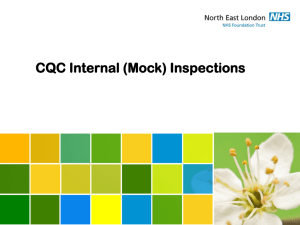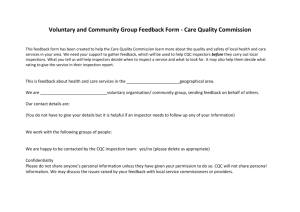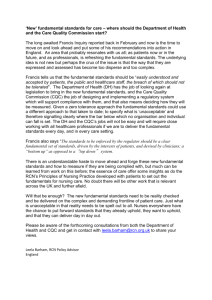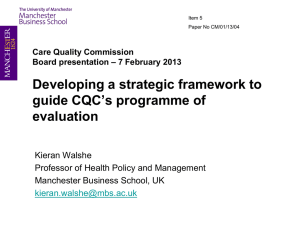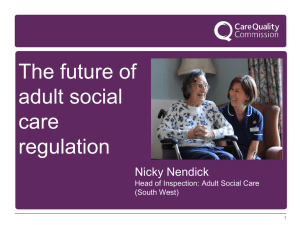Care Quality Commission insights from member focus group and interviews
advertisement
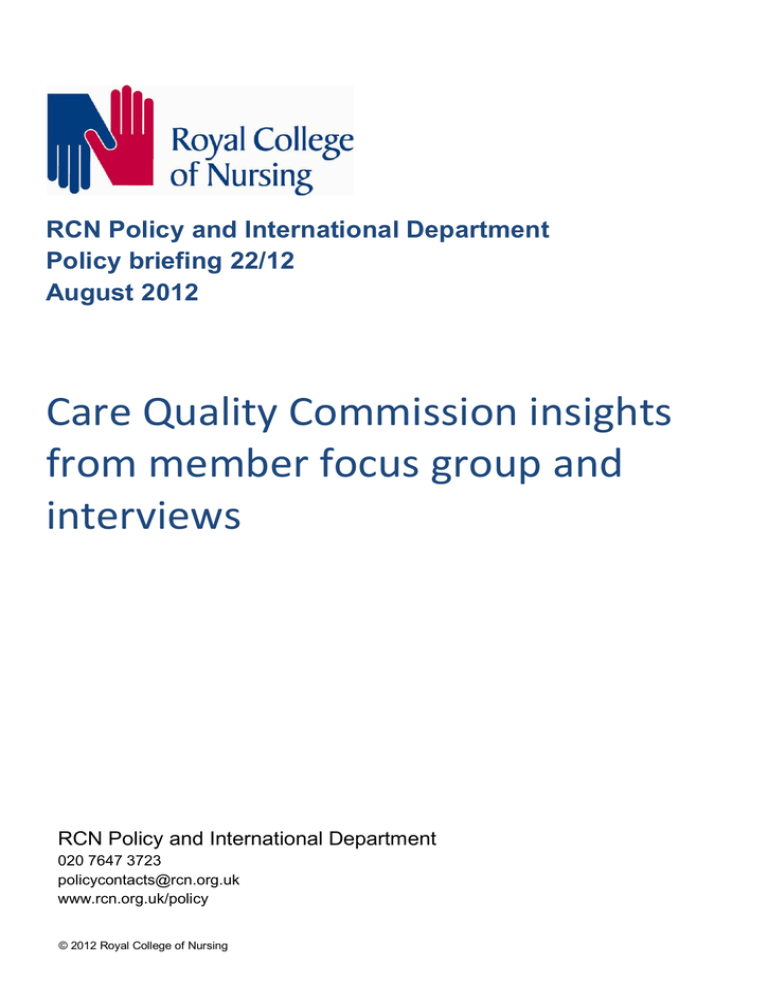
RCN Policy and International Department Policy briefing 22/12 August 2012 Care Quality Commission insights from member focus group and interviews RCN Policy and International Department 020 7647 3723 policycontacts@rcn.org.uk www.rcn.org.uk/policy © 2012 Royal College of Nursing Introduction The Royal College of Nursing has kept a close eye on the Care Quality Commission (CQC) since its inception in shadow form in 2009. This is because nurses want to be able to deliver high quality care. CQC as the independent regulator is charged with reassuring the public and patients and those who it services about quality of care and, can help nurses by: Making it clear what employers need to do to support staff in delivering the essential standards of quality and safety Provide an independent view of the quality of care being delivered Motivate change when they identify concerns about poor quality care by using their unique incentives reflecting their enforcement powers (which include criminal proceedings and possible closure of unfit providers) This means that the RCN’s members and the CQC have common and shared goals. For example, some of the RCN’s members have told us that the CQC may identify the same concerns that they have, but because the CQC has powers to intervene, employers have little choice but to respond if CQC use those powers. Whilst this is not ideal, it may be sadly necessary in these difficult times of less money and greater care needs. Members recognise that the CQC has a significant task, and one that it seems unlikely will get any easier in the future as the NHS undergoes significant change under changes from the Health and Social Care Act 2012, as well as saving £20 billion over 5 years to respond to the Nicholson Challenge. These, alongside rising demand, are generating real concerns about delivering safe high quality care. This briefing provides insights from work with members to find out in more detail their views and experience of the CQC. This builds on our previous report ‘Putting quality into the Care Quality Commission in England’1, which was based on an online survey of over 5,000 members. We recognise that the online survey was top level and the nature of the survey, via an online form, may not have given members the space and medium to talk in more depth. We conducted a 1 hour focus group during the RCN’s Congress in May 2012. Six members came to talk to us. We also held one-to-one telephone interviews with three members. Members came from a variety of backgrounds including: The independent sector Mental health Acute care Commissioning District nursing 1 RCN, Putting quality into the Care Quality Commission in England’, 2012 http://www.rcn.org.uk/__data/assets/pdf_file/0004/426478/004208.pdf 2 We also spoke to a member who works for CQC. What’s working well Members identified a number of areas where CQC is working well, although there was not necessarily consensus across all members we talked to. Essential standards – they provide a framework for members to work within. Inspectors – members who had met inspectors felt that they were professional and credible. In one area, this was perhaps because of a long standing relationship as the inspector had been part of the previous inspectorate. Recognising quality – members who had an inspection did note that good practice was also included in the inspection report. But others felt more needed to be done to recognise the good as well as the not so good, particularly when inspectors can only look at one or two wards when inspecting a large hospital. What can be improved Members felt that there were areas that the CQC could improve, or where there were mixed experiences across members. Mixed experience was highlighted in the information and communications – members liked the new CQC newsletters for example, but were frustrated that embedded links didn’t always work. This meant time to find the detail underpinning headlines in the newsletter, and because of some restrictions on the use of workplace computers, they used their own time and not work time to do this reading. Members felt that the CQC could improve in a number of areas: Staffing – members were concerned that inspectors did not always dig deeply enough on staffing levels and skill mix. Members are concerned that during an inspection staffing can be temporarily improved, and that can hide underlying issues. More broadly, members were concerned about whether and how CQC considers the dependency level of patients, which impacts on the staffing skill mix and levels that are needed to provide safe, high quality care. However, our member who works at CQC notes that whilst it may not be written into every report (that is down to the individual inspector) staffing is a core part of the inspection. Length, timing and depth of inspections – members recognise the importance of inspections as part of the broader regulatory approach. However, some are frustrated by what can be a narrow snap shot of just one or two wards in a large hospital reflecting on the organisation as a whole. And in some instances an inspection can take staff away from their caring roles, as they take time to share paperwork and discuss issues with inspectors. 3 Others however, working in smaller settings, note that the inspection can be more representative because inspectors may look at the only ward in the provider or at a care home in its entirety. Others highlighted the need for inspections to take place at different times of the day and night. Members also noted that inspections pose some practical challenges: inspectors need support on site including private space to speak to patients, service users, and staff, and will inevitably disrupt patients and service users, especially in care homes because these are people’s homes and there may be small numbers of staff (one registered nurse, for example). It is difficult to determine the best approach for CQC take, because these are setting specific issues. Our member who works for CQC notes the pressure that inspectors are under, with CQC management focused on numbers of inspections and speed, without necessarily factoring in the different levels of complexity of different providers and a high case load (around 50 or more providers per inspector). And CQC are constrained by the Department of Health policy of a generic approach. Enforcement – some members were concerned that even when issues are identified, little or no action is taken and the same issues arise each time. Disentangling this is complex because it is likely to be due to a number of factors: the nature of the risk and possible scale of harm, the action that CQC takes or not, the action that the employer takes or not, and the speed of any action that is often agreed with CQC as part of an Action Plan. But members are frustrated if they see issues and for whatever reason they are not rectified. Our member who works at CQC shares some frustrations, highlighting that there is a new enforcement policy but inspectors have received no training on using it. In fact, it can keep inspectors up at night with worrying about the care that people may be receiving and what enforcement action that they should take. They are carefully balancing the need to take action to prevent harm, but also wary of being overzealous and acting disproportionately. Whistleblowing – linked to the discussion above, one member was very saddened that despite whistleblowing CQC appeared to take a cursory look and quickly dismissed concern, relying on the view of the provider. It was only later, and after she had left, that other staff went to the press. This has led to inspection and staff changes at the unit, but only after months more of poor care. This is a real source of frustration for our member. This undermines the credibility of all the efforts to enable staff to raise concerns. They should be able to do this using their employers’ local policies and processes, and failing that approach CQC. In this instance, our member felt that the only effective route, after trying these, was the press. What the RCN would like to see The RCN has previously made a number of recommendations that we would like to see implemented to improve quality regulation, listed below. We are really pleased that some of these are already happening, but more needs to be done to build up a more credible assurance for the public and to support staff, to deliver safe, high quality care. 4 Staffing within providers 1. The CQC ensures a clearer focus on staffing by: a. providing further detail on staffing that inspectors see on their inspection visit, publicly reporting on: RN to non- RN ratios, use of an appropriate tool to determine staffing levels, actual versus establishment staffing levels and RN to patient ratios b. revisiting the Quality and Risk Profile (QRP) to see how these metrics can be incorporated in regular monitoring. 2. The Department of Health (DH) to consider whether new data collections are required for the CQC to draw upon to support their monitoring of staffing within the QRP. Inspections 3. The CQC ensures that all providers have an unannounced inspection once a year and ensures clear and transparent reporting of inspection and enforcement activity, including accurately publishing within their annual report all inspection and enforcement activity undertaken. 4. The CQC inspectors should talk to a range of staff when conducting inspections, including both senior and junior staff. They should also ensure that they speak to staff without managers present to allow staff to speak freely. 5. The CQC ensures a balance of unannounced inspections during the day and night. Whistleblowing 6. The CQC sets out a two week target for responding to those who raise concerns (if they provide their full details so that the CQC can follow up because individuals can raise concerns anonymously). The CQC should also monitor and publish their success at meeting those targets. 7. If the CQC cannot meet a two week target then they must look again at the workload of CQC staff and whether more staff are needed. Supporting the CQC’s own staff by ensuring in-house and external access to credible nursing expertise 8. The CQC must support its own staff to maintain their nursing expertise and registration, to help counter the perception of a lack of clinical expertise which undermines the credibility of inspectors and their inspection reports. 9. The CQC continues its ongoing recruitment of inspectors and reviews their training to support them in their challenging role. 5 10. The CQC explores more widespread work with nurses still in clinical practice as part of inspecting teams to build on the success of the DANI inspections. Further reading RCN, Putting quality into the Care Quality Commission in England’, 2012 http://www.rcn.org.uk/__data/assets/pdf_file/0004/426478/004208.pdf 6
